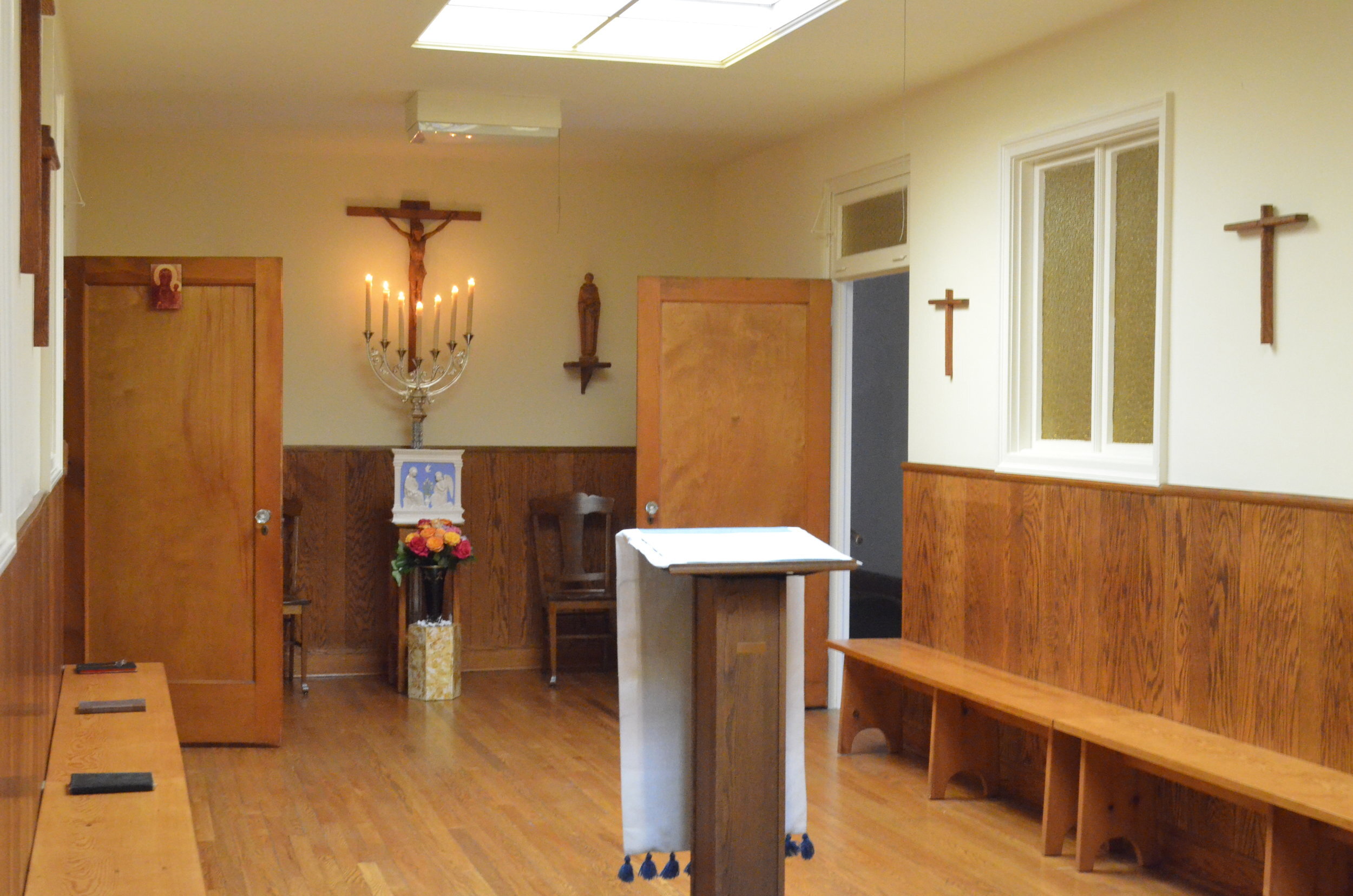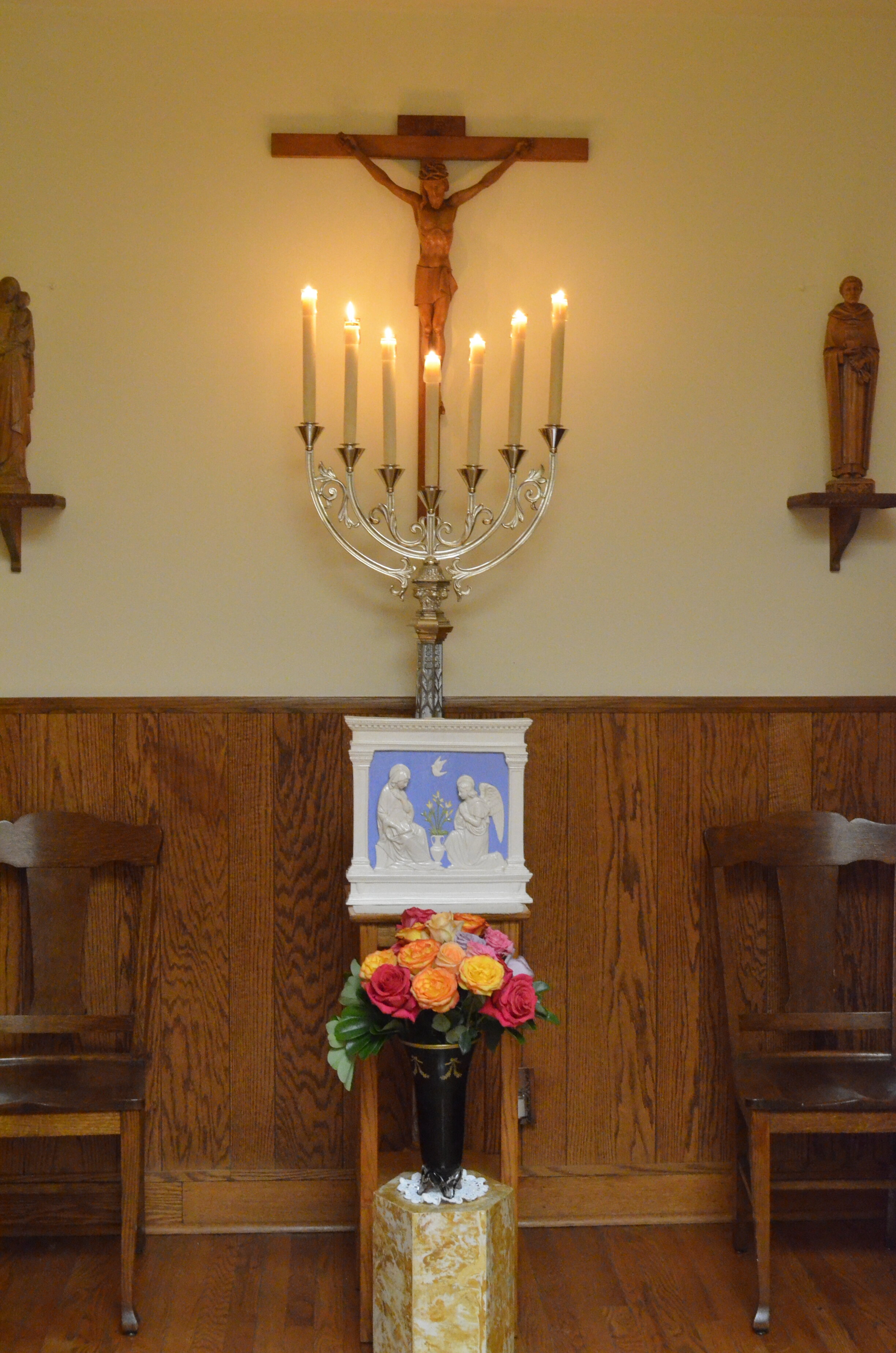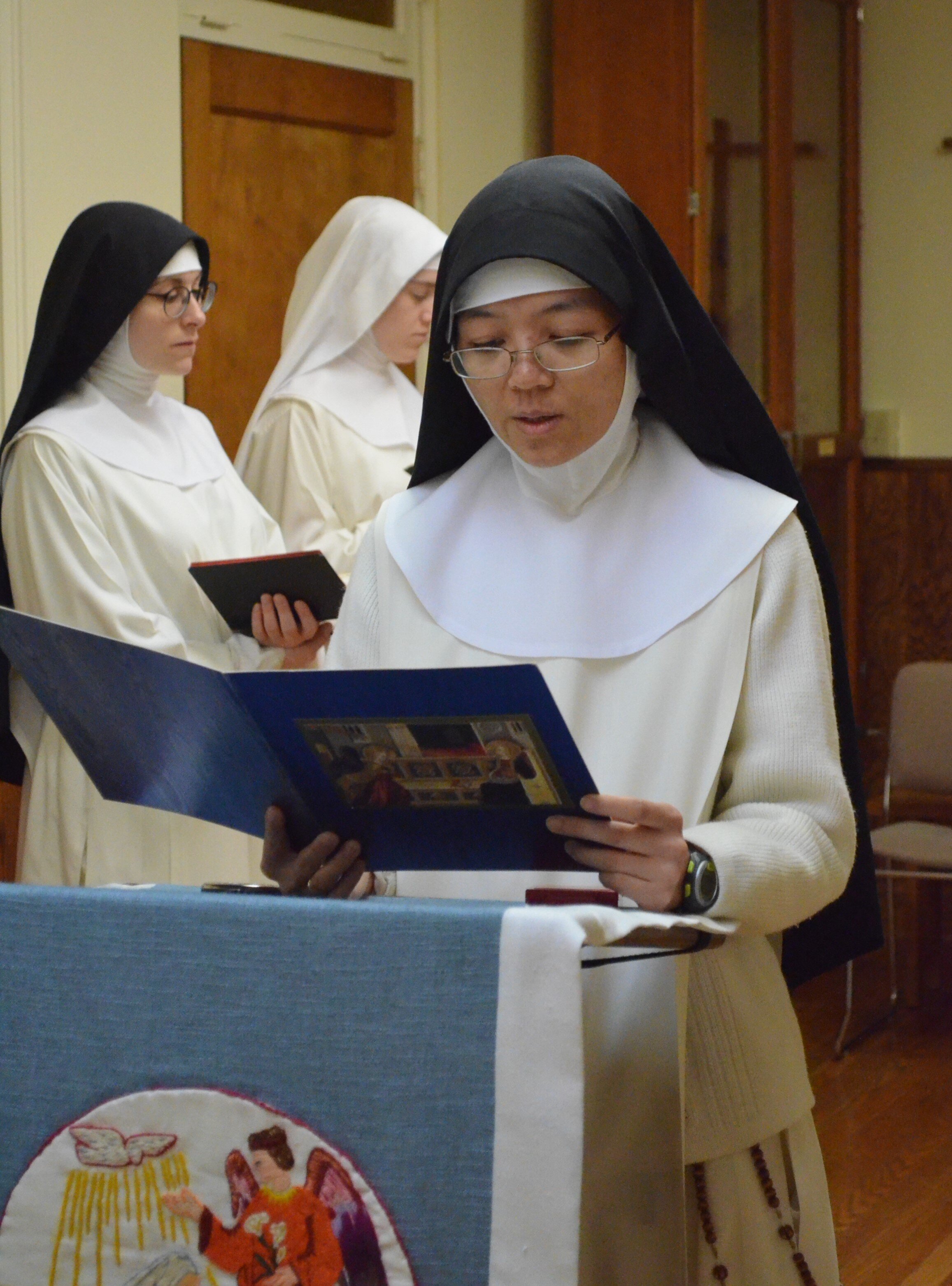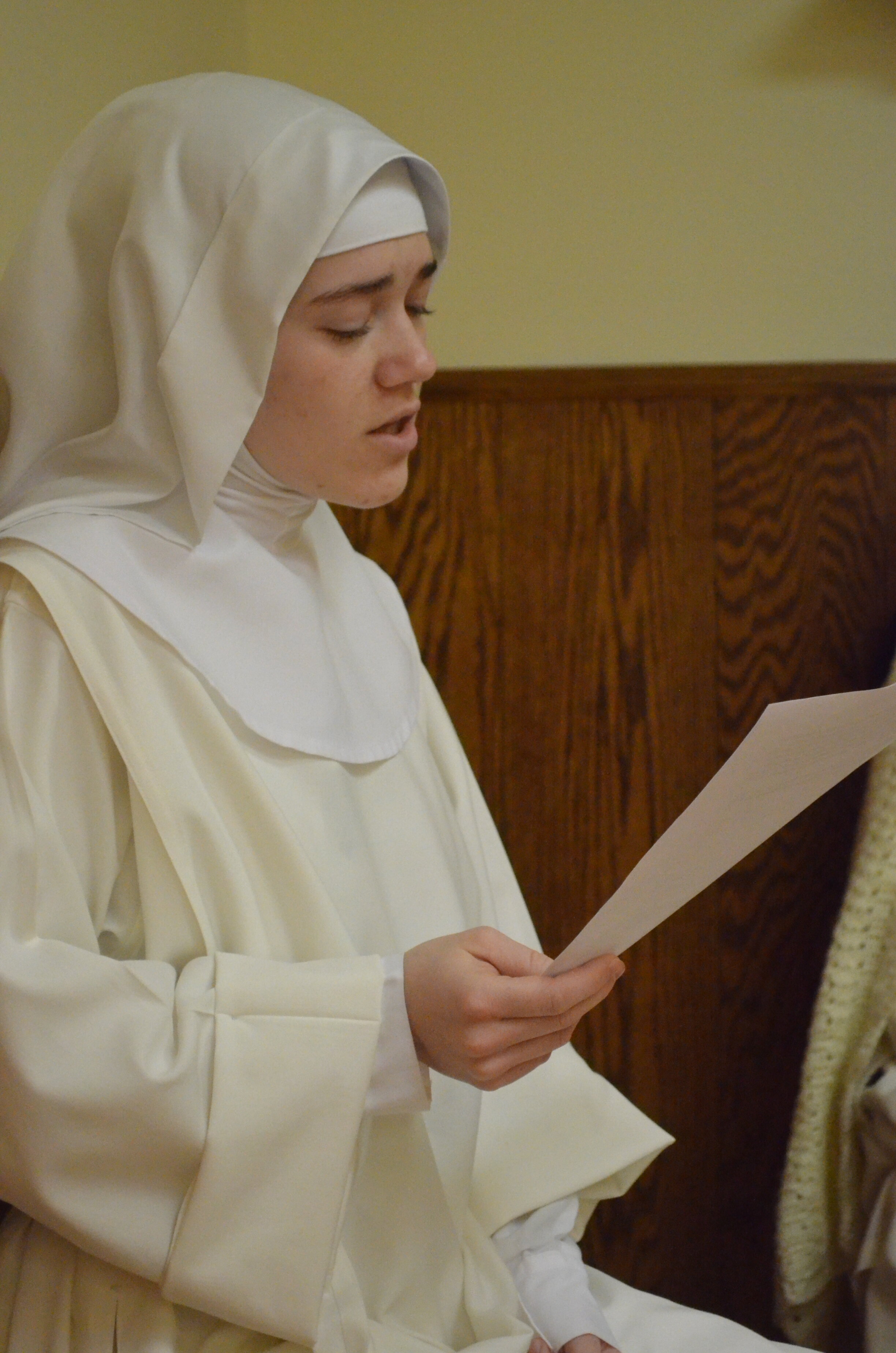Solemn Chapter of the Annunciation
The morning before the Solemnity of the Annunciation Chapter is held in place of Terce. After we all gather in the Chapter Hall one of the Chantresses chants the beginning of St. John's Gospel. This year it was Sr. Joseph Maria's turn. Afterwards the community makes the venia (a Dominican prostration done on one's right side). At the signal (the Prioress knocks) all rise and resume their places as the sister who has been asked to give the sermon comes forward.
It has been the custom in our monastery that for both the Solemn Chapter of the Annunciation and the Solemn Chapter of the Nativity the Prioress chooses another sister to give the sermon. This is always kept secret, so we never know who has been chosen until they step forward. This year Sr. Lucia Marie who was asked. She did a wonderful job, and you can read her sermon below! The Chantresses intone the Verbum Caro, and Chapter concludes with a short prayer.






Sr. Lucia Marie's Annunciation Sermon:
While the other Gospels begin with the beginning of Jesus’ public ministry, or with a brief description of Jesus’ birth, Luke starts his story with the Angel Gabriel announcing a miraculous birth, first to Zechariah, and then to Mary. Why does Luke choose to tell the story as he does? I think that perhaps Luke presents it the way he does in order to give us an example of how we too ought to hear and respond to the message of the Gospel which we are about to read in his account. Mary’s response of faith is contrasted to the disbelief of Zechariah when the angel Gabriel announces a miraculous birth to each of them. Mary hears and responds in faith to the message of the world’s salvation which is given to her, then lives it as she visits Elizabeth and eventually gives birth to Jesus.
In the Annunciation, the Gospel message of the coming savior is proclaimed to Mary – a message that contains great joy and great hope, but also entails obvious sufferings for her. Mary trusted in God, believed in his word, and accepted the angel’s message in faith. St. Augustine says that “Mary is more blessed in receiving the faith of Christ than in receiving the flesh of Christ. Her nearness as a mother would have been of no profit to Mary had she not borne Christ in her heart after a more blessed manner than in her flesh.” And so, while we may never be visited by an angel who tells us that we are going to conceive and bear the Son of God in the flesh, we can imitate Mary in this assent of faith, bearing Christ in our hearts.
The Annunciation is in a certain sense completed by the Visitation. Carrying Christ conceived within her, Mary goes out on a mission of mercy to her cousin Elizabeth. Elizabeth is profoundly moved when she hears Mary’s greeting, even saying, “And why is this granted me, that the mother of my Lord should come to me?” Our faith is not about just “us and God”, considering everyone else and their salvation as something nice but rather irrelevant to us. In fact, the first letter of John says, “If any one says, “I love God,” and hates his brother, he is a liar; for he who does not love his brother whom he has seen, cannot love God whom he has not seen.” (1 John 4:20) Loving God without loving our neighbor is impossible. Pope Benedict XVI in Spe Salvi writes: “No man is an island, entire of itself. Our lives are involved with one another; through innumerable interactions they are linked together. No one lives alone. No one sins alone. No one is saved alone.”
And so our faith is completed when we carry it out in our actions, bringing Christ to everyone we encounter, even going out of our way to encounter those whom we know need Christ brought to them. We live this out through our interactions with others, even such as just a cheerful smile towards someone, but also and in a special way for us as contemplatives, through our prayers.
This living out of our faith though never loses sight of the primary place of Mary’s example in the Annunciation. In our results-driven world view, it can be easy for us to see the value of going out and doing good, of “making a difference”, but less so to see the value of imitating Mary in encountering God in silence. There are many people who don’t even believe in God who have a sincere respect and admiration for Mother Teresa’s work among the poorest of the poor. But we forget that Mother Teresa was only able to do these things because she was first filled with God, looked first to God and then went out because this was what God was asking of her. If we imagine Mary’s Visitation without the Annunciation, it would be comparatively fruitless. It was the presence of Jesus within her that so profoundly affected both Elizabeth and John within her womb, not Mary in herself. Our desire to make a difference, to do good, even to be good can never allow us to lose sight of Mary’s example to us in the Annunciation. It is the grace of God received in faith that allows us to do the good, that changes us for the good.
This Gospel message which we receive and live is really the same thing as St. Thomas described the mission of the Dominican order – to contemplate, and to give to others the fruits of our contemplation. Looking to Mary in the Annunciation, we seek God in prayer and open our hearts to his message. Imitating Mary in the Visitation, we take Christ within us out to others. All of this reaches its fulfillment in the Nativity, when Mary gives birth to the Son of God, finally seeing with her eyes and holding in her arms what she has trustingly believed she carried within her. At the end of our lives, if we have imitated Mary in conceiving Christ in our hearts in faith, living out that faith in our lives, we shall finally see God face to face.
Mother Teresa’s resolution was to have, “A hearty “Yes” to God. A big “Smile” to all.” May we too give a hearty “Yes” to God in each moment in our life, and then bring the light of Christ to all the world by our witness and by our prayers.